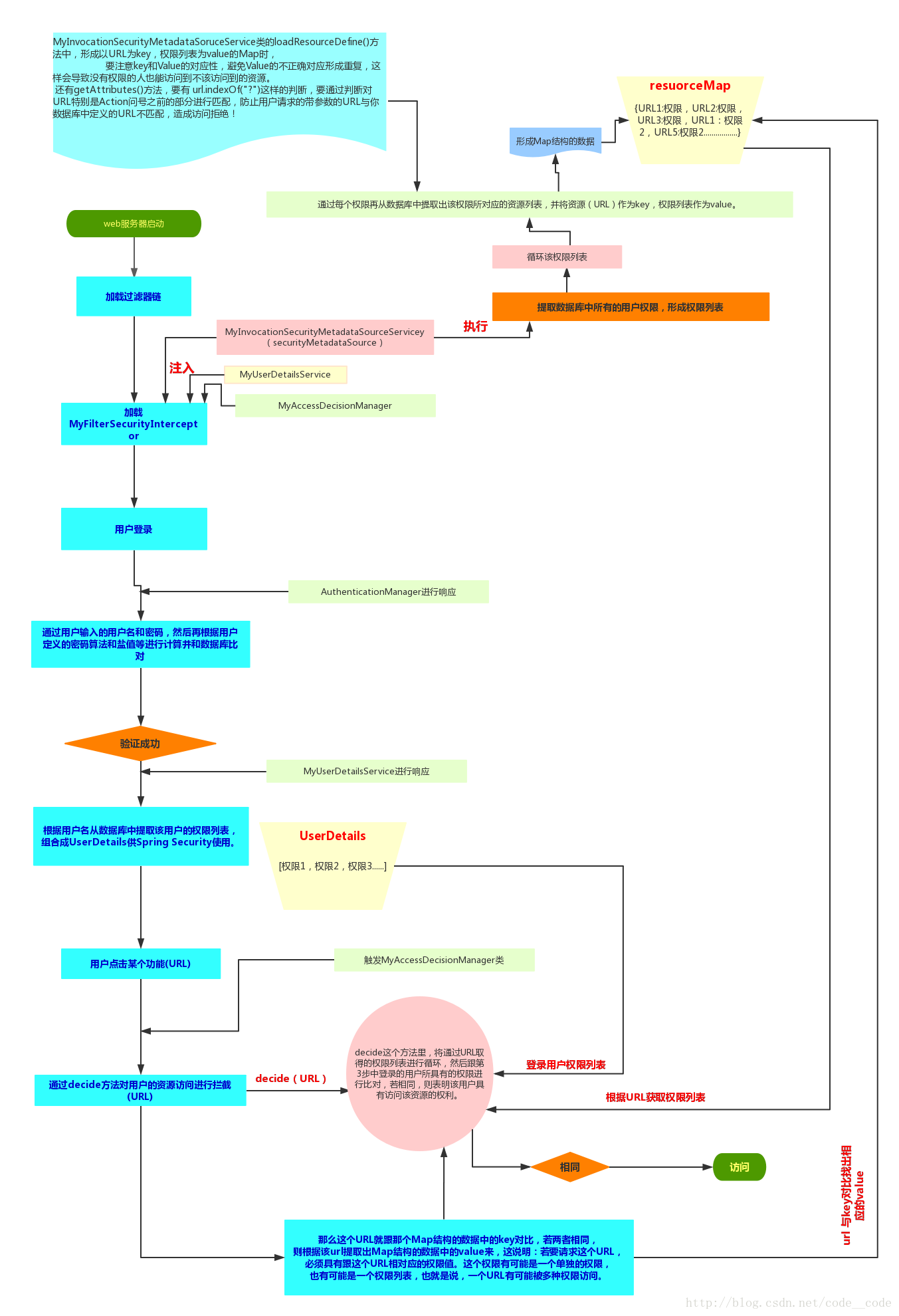Spring Boot Security 详解
简介
Spring Security,这是一种基于 Spring AOP 和 Servlet 过滤器的安全框架。它提供全面的安全性解决方案,同时在 Web 请求级和方法调用级处理身份确认和授权。
工作流程
从网上找了一张Spring Security 的工作流程图,如下。

图中标记的MyXXX,就是我们项目中需要配置的。
快速上手
建表
表结构

建表语句
DROP TABLE IF EXISTS `user`;
DROP TABLE IF EXISTS `role`;
DROP TABLE IF EXISTS `user_role`;
DROP TABLE IF EXISTS `role_permission`;
DROP TABLE IF EXISTS `permission`;
CREATE TABLE `user` (
`id` bigint(11) NOT NULL AUTO_INCREMENT,
`username` varchar(255) NOT NULL,
`password` varchar(255) NOT NULL,
PRIMARY KEY (`id`)
);
CREATE TABLE `role` (
`id` bigint(11) NOT NULL AUTO_INCREMENT,
`name` varchar(255) NOT NULL,
PRIMARY KEY (`id`)
);
CREATE TABLE `user_role` (
`user_id` bigint(11) NOT NULL,
`role_id` bigint(11) NOT NULL
);
CREATE TABLE `role_permission` (
`role_id` bigint(11) NOT NULL,
`permission_id` bigint(11) NOT NULL
);
CREATE TABLE `permission` (
`id` bigint(11) NOT NULL AUTO_INCREMENT,
`url` varchar(255) NOT NULL,
`name` varchar(255) NOT NULL,
`description` varchar(255) NULL,
`pid` bigint(11) NOT NULL,
PRIMARY KEY (`id`)
);
INSERT INTO user (id, username, password) VALUES (1,'user','e10adc3949ba59abbe56e057f20f883e');
INSERT INTO user (id, username , password) VALUES (2,'admin','e10adc3949ba59abbe56e057f20f883e');
INSERT INTO role (id, name) VALUES (1,'USER');
INSERT INTO role (id, name) VALUES (2,'ADMIN');
INSERT INTO permission (id, url, name, pid) VALUES (1,'/user/common','common',0);
INSERT INTO permission (id, url, name, pid) VALUES (2,'/user/admin','admin',0);
INSERT INTO user_role (user_id, role_id) VALUES (1, 1);
INSERT INTO user_role (user_id, role_id) VALUES (2, 1);
INSERT INTO user_role (user_id, role_id) VALUES (2, 2);
INSERT INTO role_permission (role_id, permission_id) VALUES (1, 1);
INSERT INTO role_permission (role_id, permission_id) VALUES (2, 1);
INSERT INTO role_permission (role_id, permission_id) VALUES (2, 2);
pom.xml
<dependency>
<groupId>org.springframework.boot</groupId>
<artifactId>spring-boot-starter-security</artifactId>
</dependency>
<dependency>
<groupId>org.springframework.boot</groupId>
<artifactId>spring-boot-starter-thymeleaf</artifactId>
</dependency>
<dependency>
<groupId>org.springframework.boot</groupId>
<artifactId>spring-boot-starter-web</artifactId>
</dependency>
<dependency>
<groupId>org.thymeleaf.extras</groupId>
<artifactId>thymeleaf-extras-security4</artifactId>
</dependency>
application.yml
spring:
thymeleaf:
mode: HTML5
encoding: UTF-8
cache: false
datasource:
driver-class-name: com.mysql.cj.jdbc.Driver
url: jdbc:mysql://localhost:3306/spring-security?useUnicode=true&characterEncoding=utf-8&useSSL=false
username: root
password: root
User
public class User implements UserDetails , Serializable {
private Long id;
private String username;
private String password;
private List<Role> authorities;
public Long getId() {
return id;
}
public void setId(Long id) {
this.id = id;
}
@Override
public String getUsername() {
return username;
}
public void setUsername(String username) {
this.username = username;
}
@Override
public String getPassword() {
return password;
}
public void setPassword(String password) {
this.password = password;
}
@Override
public List<Role> getAuthorities() {
return authorities;
}
public void setAuthorities(List<Role> authorities) {
this.authorities = authorities;
}
/**
* 用户账号是否过期
*/
@Override
public boolean isAccountNonExpired() {
return true;
}
/**
* 用户账号是否被锁定
*/
@Override
public boolean isAccountNonLocked() {
return true;
}
/**
* 用户密码是否过期
*/
@Override
public boolean isCredentialsNonExpired() {
return true;
}
/**
* 用户是否可用
*/
@Override
public boolean isEnabled() {
return true;
}
}
上面的 User 类实现了 UserDetails 接口,该接口是实现Spring Security 认证信息的核心接口。其中 getUsername 方法为 UserDetails 接口 的方法,这个方法返回 username,也可以是其他的用户信息,例如手机号、邮箱等。getAuthorities() 方法返回的是该用户设置的权限信息,在本实例中,从数据库取出用户的所有角色信息,权限信息也可以是用户的其他信息,不一定是角色信息。另外需要读取密码,最后几个方法一般情况下都返回 true,也可以根据自己的需求进行业务判断。
Role
public class Role implements GrantedAuthority {
private Long id;
private String name;
public Long getId() {
return id;
}
public void setId(Long id) {
this.id = id;
}
public String getName() {
return name;
}
public void setName(String name) {
this.name = name;
}
@Override
public String getAuthority() {
return name;
}
}
Role 类实现了 GrantedAuthority 接口,并重写 getAuthority() 方法。权限点可以为任何字符串,不一定非要用角色名。
所有的Authentication实现类都保存了一个GrantedAuthority列表,其表示用户所具有的权限。GrantedAuthority是通过AuthenticationManager设置到Authentication对象中的,然后AccessDecisionManager将从Authentication中获取用户所具有的GrantedAuthority来鉴定用户是否具有访问对应资源的权限。
MyUserDetailsService
@Service
public class MyUserDetailsService implements UserDetailsService {
@Autowired
private UserMapper userMapper;
@Autowired
private RoleMapper roleMapper;
@Override
public UserDetails loadUserByUsername(String userName) throws UsernameNotFoundException {
//查数据库
User user = userMapper.loadUserByUsername( userName );
if (null != user) {
List<Role> roles = roleMapper.getRolesByUserId( user.getId() );
user.setAuthorities( roles );
}
return user;
}
}
Service 层需要实现 UserDetailsService 接口,该接口是根据用户名获取该用户的所有信息, 包括用户信息和权限点。
MyInvocationSecurityMetadataSourceService
@Component
public class MyInvocationSecurityMetadataSourceService implements FilterInvocationSecurityMetadataSource {
@Autowired
private PermissionMapper permissionMapper;
/**
* 每一个资源所需要的角色 Collection<ConfigAttribute>决策器会用到
*/
private static HashMap<String, Collection<ConfigAttribute>> map =null;
/**
* 返回请求的资源需要的角色
*/
@Override
public Collection<ConfigAttribute> getAttributes(Object o) throws IllegalArgumentException {
if (null == map) {
loadResourceDefine();
}
//object 中包含用户请求的request 信息
HttpServletRequest request = ((FilterInvocation) o).getHttpRequest();
for (Iterator<String> it = map.keySet().iterator() ; it.hasNext();) {
String url = it.next();
if (new AntPathRequestMatcher( url ).matches( request )) {
return map.get( url );
}
}
return null;
}
@Override
public Collection<ConfigAttribute> getAllConfigAttributes() {
return null;
}
@Override
public boolean supports(Class<?> aClass) {
return true;
}
/**
* 初始化 所有资源 对应的角色
*/
public void loadResourceDefine() {
map = new HashMap<>(16);
//权限资源 和 角色对应的表 也就是 角色权限 中间表
List<RolePermisson> rolePermissons = permissionMapper.getRolePermissions();
//某个资源 可以被哪些角色访问
for (RolePermisson rolePermisson : rolePermissons) {
String url = rolePermisson.getUrl();
String roleName = rolePermisson.getRoleName();
ConfigAttribute role = new SecurityConfig(roleName);
if(map.containsKey(url)){
map.get(url).add(role);
}else{
List<ConfigAttribute> list = new ArrayList<>();
list.add( role );
map.put( url , list );
}
}
}
}
MyInvocationSecurityMetadataSourceService 类实现了 FilterInvocationSecurityMetadataSource,FilterInvocationSecurityMetadataSource 的作用是用来储存请求与权限的对应关系。
FilterInvocationSecurityMetadataSource接口有3个方法:
- boolean supports(Class<?> clazz):指示该类是否能够为指定的方法调用或Web请求提供ConfigAttributes。
- Collection<ConfigAttribute> getAllConfigAttributes():Spring容器启动时自动调用, 一般把所有请求与权限的对应关系也要在这个方法里初始化, 保存在一个属性变量里。
- Collection<ConfigAttribute> getAttributes(Object object):当接收到一个http请求时, filterSecurityInterceptor会调用的方法. 参数object是一个包含url信息的HttpServletRequest实例. 这个方法要返回请求该url所需要的所有权限集合。
MyAccessDecisionManager
/**
* 决策器
*/
@Component
public class MyAccessDecisionManager implements AccessDecisionManager {
private final static Logger logger = LoggerFactory.getLogger(MyAccessDecisionManager.class);
/**
* 通过传递的参数来决定用户是否有访问对应受保护对象的权限
*
* @param authentication 包含了当前的用户信息,包括拥有的权限。这里的权限来源就是前面登录时UserDetailsService中设置的authorities。
* @param object 就是FilterInvocation对象,可以得到request等web资源
* @param configAttributes configAttributes是本次访问需要的权限
*/
@Override
public void decide(Authentication authentication, Object object, Collection<ConfigAttribute> configAttributes) throws AccessDeniedException, InsufficientAuthenticationException {
if (null == configAttributes || 0 >= configAttributes.size()) {
return;
} else {
String needRole;
for(Iterator<ConfigAttribute> iter = configAttributes.iterator(); iter.hasNext(); ) {
needRole = iter.next().getAttribute();
for(GrantedAuthority ga : authentication.getAuthorities()) {
if(needRole.trim().equals(ga.getAuthority().trim())) {
return;
}
}
}
throw new AccessDeniedException("当前访问没有权限");
}
}
/**
* 表示此AccessDecisionManager是否能够处理传递的ConfigAttribute呈现的授权请求
*/
@Override
public boolean supports(ConfigAttribute configAttribute) {
return true;
}
/**
* 表示当前AccessDecisionManager实现是否能够为指定的安全对象(方法调用或Web请求)提供访问控制决策
*/
@Override
public boolean supports(Class<?> aClass) {
return true;
}
}
MyAccessDecisionManager 类实现了AccessDecisionManager接口,AccessDecisionManager是由AbstractSecurityInterceptor调用的,它负责鉴定用户是否有访问对应资源(方法或URL)的权限。
MyFilterSecurityInterceptor
@Component
public class MyFilterSecurityInterceptor extends AbstractSecurityInterceptor implements Filter {
@Autowired
private FilterInvocationSecurityMetadataSource securityMetadataSource;
@Autowired
public void setMyAccessDecisionManager(MyAccessDecisionManager myAccessDecisionManager) {
super.setAccessDecisionManager(myAccessDecisionManager);
}
@Override
public void doFilter(ServletRequest servletRequest, ServletResponse servletResponse, FilterChain filterChain) throws IOException, ServletException {
FilterInvocation fi = new FilterInvocation(servletRequest, servletResponse, filterChain);
invoke(fi);
}
public void invoke(FilterInvocation fi) throws IOException, ServletException {
InterceptorStatusToken token = super.beforeInvocation(fi);
try {
//执行下一个拦截器
fi.getChain().doFilter(fi.getRequest(), fi.getResponse());
} finally {
super.afterInvocation(token, null);
}
}
@Override
public Class<?> getSecureObjectClass() {
return FilterInvocation.class;
}
@Override
public SecurityMetadataSource obtainSecurityMetadataSource() {
return this.securityMetadataSource;
}
}
每种受支持的安全对象类型(方法调用或Web请求)都有自己的拦截器类,它是AbstractSecurityInterceptor的子类,AbstractSecurityInterceptor 是一个实现了对受保护对象的访问进行拦截的抽象类。
AbstractSecurityInterceptor的机制可以分为几个步骤:
- 查找与当前请求关联的“配置属性(简单的理解就是权限)”
- 将 安全对象(方法调用或Web请求)、当前身份验证、配置属性 提交给决策器(AccessDecisionManager)
- (可选)更改调用所根据的身份验证
- 允许继续进行安全对象调用(假设授予了访问权)
- 在调用返回之后,如果配置了AfterInvocationManager。如果调用引发异常,则不会调用AfterInvocationManager。
AbstractSecurityInterceptor中的方法说明:
- beforeInvocation()方法实现了对访问受保护对象的权限校验,内部用到了AccessDecisionManager和AuthenticationManager;
- finallyInvocation()方法用于实现受保护对象请求完毕后的一些清理工作,主要是如果在beforeInvocation()中改变了SecurityContext,则在finallyInvocation()中需要将其恢复为原来的SecurityContext,该方法的调用应当包含在子类请求受保护资源时的finally语句块中。
- afterInvocation()方法实现了对返回结果的处理,在注入了AfterInvocationManager的情况下默认会调用其decide()方法。
了解了AbstractSecurityInterceptor,就应该明白了,我们自定义MyFilterSecurityInterceptor就是想使用我们之前自定义的 AccessDecisionManager 和 securityMetadataSource。
SecurityConfig
@EnableWebSecurity注解以及WebSecurityConfigurerAdapter一起配合提供基于web的security。自定义类 继承了WebSecurityConfigurerAdapter来重写了一些方法来指定一些特定的Web安全设置。
@Configuration
@EnableWebSecurity
public class SecurityConfig extends WebSecurityConfigurerAdapter {
@Autowired
private MyUserDetailsService userService;
@Autowired
public void configureGlobal(AuthenticationManagerBuilder auth) throws Exception {
//校验用户
auth.userDetailsService( userService ).passwordEncoder( new PasswordEncoder() {
//对密码进行加密
@Override
public String encode(CharSequence charSequence) {
System.out.println(charSequence.toString());
return DigestUtils.md5DigestAsHex(charSequence.toString().getBytes());
}
//对密码进行判断匹配
@Override
public boolean matches(CharSequence charSequence, String s) {
String encode = DigestUtils.md5DigestAsHex(charSequence.toString().getBytes());
boolean res = s.equals( encode );
return res;
}
} );
}
@Override
protected void configure(HttpSecurity http) throws Exception {
http.authorizeRequests()
.antMatchers("/","index","/login","/login-error","/401","/css/**","/js/**").permitAll()
.anyRequest().authenticated()
.and()
.formLogin().loginPage( "/login" ).failureUrl( "/login-error" )
.and()
.exceptionHandling().accessDeniedPage( "/401" );
http.logout().logoutSuccessUrl( "/" );
}
}
MainController
@Controller
public class MainController {
@RequestMapping("/")
public String root() {
return "redirect:/index";
}
@RequestMapping("/index")
public String index() {
return "index";
}
@RequestMapping("/login")
public String login() {
return "login";
}
@RequestMapping("/login-error")
public String loginError(Model model) {
model.addAttribute( "loginError" , true);
return "login";
}
@GetMapping("/401")
public String accessDenied() {
return "401";
}
@GetMapping("/user/common")
public String common() {
return "user/common";
}
@GetMapping("/user/admin")
public String admin() {
return "user/admin";
}
}
页面
login.html
<!DOCTYPE html>
<html xmlns="http://www.w3.org/1999/xhtml" xmlns:th="http://www.thymeleaf.org">
<head>
<meta charset="UTF-8">
<title>登录</title>
</head>
<body>
<h1>Login page</h1>
<p th:if="${loginError}" class="error">用户名或密码错误</p>
<form th:action="@{/login}" method="post">
<label for="username">用户名</label>:
<input type="text" id="username" name="username" autofocus="autofocus" />
<br/>
<label for="password">密 码</label>:
<input type="password" id="password" name="password" />
<br/>
<input type="submit" value="登录" />
</form>
<p><a href="/index" th:href="@{/index}"></a></p>
</body>
</html>
index.html
<!DOCTYPE html>
<html lang="en" xmlns:th="http://www.thymeleaf.org">
<head>
<head>
<meta charset="UTF-8">
<title>首页</title>
</head>
<body>
<h2>page list</h2>
<a href="/user/common">common page</a>
<br/>
<a href="/user/admin">admin page</a>
<br/>
<form th:action="@{/logout}" method="post">
<input type="submit" class="btn btn-primary" value="注销"/>
</form>
</body>
</html>
admin.html
<!DOCTYPE html>
<head>
<meta charset="UTF-8">
<title>admin page</title>
</head>
<body>
success admin page!!!
</body>
</html>
common.html
<!DOCTYPE html>
<head>
<meta charset="UTF-8">
<title>common page</title>
</head>
<body>
success common page!!!
</body>
</html>
401.html
<!DOCTYPE html>
<html lang="en">
<head>
<meta charset="UTF-8">
<title>401 page</title>
</head>
<body>
<div>
<div>
<h2>权限不够</h2>
<p>拒绝访问!</p>
</div>
</div>
</body>
</html>
最后运行项目,可以分别用 user、admin 账号 去测试认证和授权是否正确。
参考
《深入理解Spring Cloud与微服务构建》
https://www.ktanx.com/blog/p/4929
源码
https://github.com/gf-huanchupk/SpringBootLearning/tree/master/springboot-security
欢迎扫码或微信搜索公众号《程序员果果》关注我,关注有惊喜~

Spring Boot Security 详解的更多相关文章
- Spring Boot 配置文件详解
Spring Boot配置文件详解 Spring Boot提供了两种常用的配置文件,分别是properties文件和yml文件.他们的作用都是修改Spring Boot自动配置的默认值.相对于prop ...
- Spring Boot异常处理详解
在Spring MVC异常处理详解中,介绍了Spring MVC的异常处理体系,本文将讲解在此基础上Spring Boot为我们做了哪些工作.下图列出了Spring Boot中跟MVC异常处理相关的类 ...
- Spring Boot (九): 微服务应用监控 Spring Boot Actuator 详解
1. 引言 在当前的微服务架构方式下,我们会有很多的服务部署在不同的机器上,相互是通过服务调用的方式进行交互,一个完整的业务流程中间会经过很多个微服务的处理和传递,那么,如何能知道每个服务的健康状况就 ...
- Spring Boot 注解详解
一.注解(annotations)列表 @SpringBootApplication:包含了@ComponentScan.@Configuration和@EnableAutoConfiguration ...
- Spring Boot配置文件详解-ConfigurationProperties和Value优缺点-(转)好文
文章转自 http://www.cnblogs.com/itdragon/p/8686554.html Spring Boot提供了两种常用的配置文件,分别是properties文件和yml文件.他们 ...
- (转) SpringBoot非官方教程 | 第二篇:Spring Boot配置文件详解
springboot采纳了建立生产就绪spring应用程序的观点. Spring Boot优先于配置的惯例,旨在让您尽快启动和运行.在一般情况下,我们不需要做太多的配置就能够让spring boot正 ...
- SpringBoot非官方教程 | 第二篇:Spring Boot配置文件详解
转载请标明出处: 原文首发于:https://www.fangzhipeng.com/springboot/2017/07/11/springboot2-config-file/ 本文出自方志朋的博客 ...
- Spring boot 配置文件详解 (properties 和yml )
从其他框架来看 我们都有自己的配置文件, hibernate有hbm,mybatis 有properties, 同样, Spring boot 也有全局配置文件. Springboot使用一个全局的配 ...
- Spring Boot Admin 详解(Spring Boot 2.0,基于 Eureka 的实现)
原文:https://blog.csdn.net/hubo_88/article/details/80671192 Spring Boot Admin 用于监控基于 Spring Boot 的应用,它 ...
随机推荐
- FPGA学习笔记(七)——FSM(Finite State Machine,有限状态机)设计
FPGA设计中,最重要的设计思想就是状态机的设计思想!状态机的本质就是对具有逻辑顺序和时序规律的事件的一种描述方法,它有三个要素:状态.输入.输出:状态也叫做状态变量(比如可以用电机的不同转速作为状态 ...
- Quartz定时调度在Web中的应用
1.在数据库中建一个job表和job日志表 job表
- TiDB show processlist命令源码分析
背景 因为丰巢自去年年底开始在推送平台上尝试了TiDB,最近又要将承接丰巢所有交易的支付平台切到TiDB上.我本人一直没有抽出时间对TiDB的源码进行学习,最近准备开始一系列的学习和分享.由于我本人没 ...
- 贝叶斯深度学习(bayesian deep learning)
本文简单介绍什么是贝叶斯深度学习(bayesian deep learning),贝叶斯深度学习如何用来预测,贝叶斯深度学习和深度学习有什么区别.对于贝叶斯深度学习如何训练,本文只能大致给个介绍. ...
- netty源码学习
概述 Netty is an asynchronous event-driven network application framework for rapid development of main ...
- 这可能是史上最好的 Java8 新特性 Stream 流教程
本文翻译自 https://winterbe.com/posts/2014/07/31/java8-stream-tutorial-examples/ 作者: @Winterbe 欢迎关注个人微信公众 ...
- 学习python的第一天
2019.4.25自我总结 一.Typora 关于用Typora 自我感觉良好,基本快捷键也比较简单,ps:还是要多用用 二.编程 1.编程语言 是用来定义计算机程序的形式语言.它是一种被标准化的交流 ...
- eureka服务搭建
Server端 引入eureka server的maven依赖 引入依赖时无需给定eureka的版本号,maven会根据当前使用的SpringCloud版本来判断应该引入哪个版本的euraka ser ...
- 04. 启停redis服务
启动 查看redis.conf文件,可以通过general中的说明,配置通过systemd来启停redis和查看redis状态(作者没有采用,而是使用service管理,service配置参考< ...
- 企业自主可控免费开源ERP:Odoo采购管理解决方案
供应商基础资料 1. 所有的供应商基础资料,Odoo开账启用时,期初的客户数据如果大于200条,可以批量导入: 2. 点“采购/采购/供应商”菜单可以查看.编辑修改.搜索所有的供应商基础资料: 3. ...
